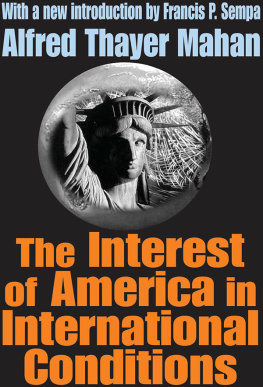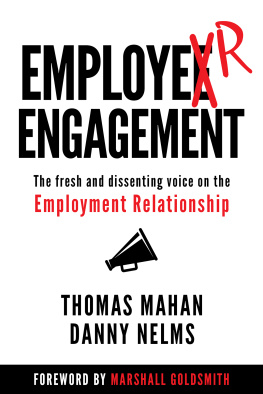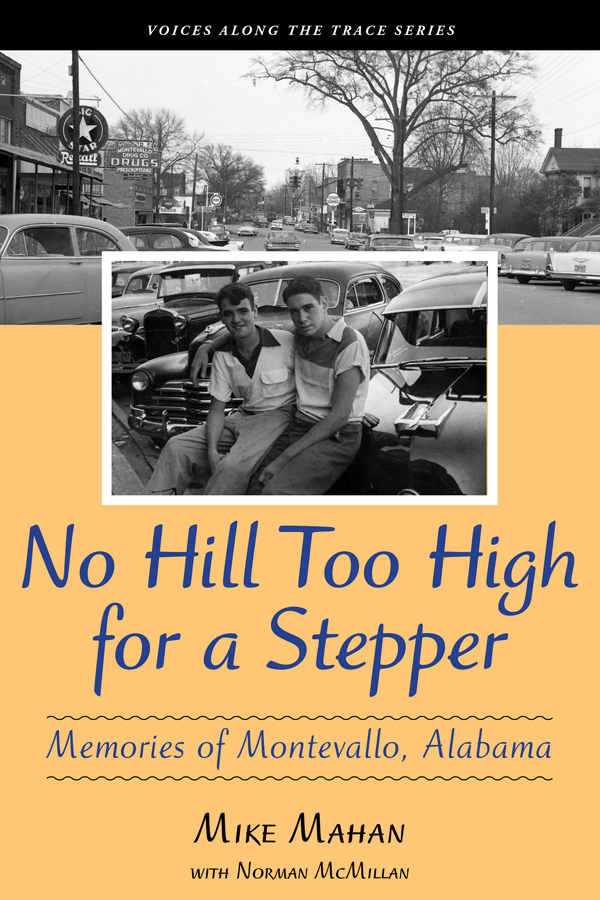No Hill Too High for a Stepper
Memories of Montevallo, Alabama
Mike Mahan
with Norman McMillan
NewSouth Books
Montgomery
Published in cooperation with
The Cahaba Trace Commission
Voices Along the Trace Series
NewSouth Books
105 S. Court Street
Montgomery, AL 36104
Copyright 2014 by Mike Mahan. All rights reserved under International and Pan-American Copyright Conventions. Published in the United States by NewSouth Books, a division of NewSouth, Inc., Montgomery, Alabama in cooperation with The Cahaba Trace Commission Voices Along the Trace Series.
The Montevallo As I Remember It map, printed in an alternate edition of this text, can be viewed in full at www.newsouthbooks.com/stepper/map.
ISBN: 978-1-60306-357-9
eBook ISBN: 978-1-60306-358-6
Library of Congress Control Number: 2014933019
Visit www.newsouthbooks.com
To My Family:
To Linda, Neeno, the smartest, most intellectual, most serious, most beautiful, most understanding, most patient, and most loving wife a guy could have.
To Stann Mahan Garris and Miki Mahan Heaton, my two very successful daughters, both of whom during their lives have resided at my childhood home, 159 Shelby Street. There Stann conceived two of my grandsons, both of whom have lived there. Miki, who was conceived in the basement of the house on Shelby Street, grew up and matured with Big Mama and Poppy upstairs in that house.
To the boys. To my caring, receptive, athletic, and loving grandson Michael, now twenty-five years old, who visited regularly at 159 Shelby Street. To Jacob, now twenty-two years old, a smart, talented, beautiful grandson, who is the phrase everybody loves Jacob. To grandson Jesse, now eighteen years old, a man of few words, whose academic, athletic, and musical abilities speak for him. Both Jacob and Jesse spent their first night out of the hospital on Shelby Street, and there both shared many of the same experiences of fun, discipline, pain, and pleasure I did when I resided there.
To all of the above, I hope that this narrative will give you something to talk about when I am dead and gone.
Contents
Preface
In 1983, David Ward, one of my friends from Highland Avenue in Montevallo, Alabama, published a short narrative entitled Lamar and Me , which described a special friendship that developed between him and a neighbor, Lamar Appleton, as they grew up in Montevallo. So much of what was in Davids book rang true to me that I began to think about how important growing up in a small, diversified, academic community like Montevallo had been to me as well. And many of my contemporaries in Montevallo felt the same way.
With the success of Lamar and Me , a group of usincluding Ed Givhan, Joy Holcombe, Gene Baldwin, Barbara Belisle, me, and, of course, David Ward and Lamar Appletonthought it might be fun to write a book on our lives in Montevallo. Each would write a chapter or two, after which David would put his expert editorial skills to work. In 2000, the book, entitled Time Has Made a Change in Me , was completed and published, and, judging by the comments of readers, well-received.
My chapter in Time Has Made a Change in Me was called In Praise of Shelby Street. The other authors were from Highland Avenue and other parts of town, but I was the only Shelby Street or Frog Holler contributor. After the book came out, Ed Givhan would tell me repeatedly, Mahan, you have only just begun. You need to write a book about growing up on Shelby Street. Lifelong friends, we shared an interest in Alabama history, and he seldom said anything I didnt listen to seriously. He and I had hoped to do a book on historical homes of the Black Belt of Alabama, along with photographer Chip Cooper and Robert Gamble of the Alabama Historical Commission, but both Ed and Chip Cooper had other books to complete, and Ed and his wife, Peggy, were busy restoring a portion of the old family farm near Browns, Alabama. That project was stalled, however, when Ed became very ill. Still, when we were together he seemed always to bring up a book on Shelby Street. I was in his hospital room two days before he died on November 15, 2004. During that visit, he said in a quiet whisper that I had to get busy writing about Shelby Street. For me that was a great commission, and I have been committed to writing a book on the subject ever since.
Another person who urged me to write a memoir is my close friend Marty Everse, who is also devoted to Alabama history. I want to pay special tribute to Marty, who has always been able to bring my blue-sky projects down to earth and has helped me bring many dreams to fruition. I also owe him many thanks for his many hours scanning and editing the many photographs contained in this book. And to his wonderful wife Helon, better known as Sweet Pea, thanks for sharing. Marty and I have worked together with the Alabama Historical Commission, the Alabama Historic Ironworks Commission, and the Cahaba Trace Commission, which among other things publishes books on the Cahaba Trace region which is made up of counties that border the Cahaba River system. The Commission established a series of memoirs called Voices Along the Trace. I have written this book with that series in mind.
If any readers enjoy this manuscript, it is because of my friend and writing partner, Norman McMillan. Without his help, this narrative would not have come to completion. On many mornings, I arrived at Norman and Mama Joans home at seven oclock , and Norman and I would spend time talking about the people and events that are included in this memoir or sitting at the computer revising the manuscript. To Norman and Joan, all I can say is thanks, thanks, and more thanks for sharing their home and Normans talent and time.
I must also pay tribute to Misty Jones, a lady who has helped immeasurably in putting my thoughts on paper. Without her, this book would have been impossible.
The petticoat dynasty at the Brierfield Dental office have tolerated, helped, and put up with me for a combined 126 years. To Margie, Betty, Glenda, Sandy (who for years has said, Come on, Doc, we got to go to work), Crystal, Amy, Kristy, and Renee (Muffet), I can only say thanks for your putting up with this and encouraging me. Special thanks go to two dear friends, Steve Huffstutler and Tim Wilson, for lending their editorial skills to this effort.
The many photographs in this book came from family and friends, many of whom are mentioned in the memoir. I want to particularly thank the University of Montevallo and its archivist Carey Weatherly for helping with the photographs.
To my classmate in elementary and high school and lifelong friend Emily Pendleton, I cannot count how many phone calls she answered helping me with dates and names. Thanks and I love you, Emily.
To Katie Johnston, I owe thanks for her many hours of copying, numbering, and ordering the photographs as well as for placing into three-ring binders all the drafts Norman sent.
My chief motivation for writing this memoir has been to pay tribute and say thanks to the many individuals who made Shelby Street and Montevallo a launch pad for my life.
Part I
Family
Beginnings
When my wife Linda and I celebrated our thirty-ninth anniversary in 2001, I rented a room for the night in the tower of the McKibbon House Bed and Breakfast in Montevallo, Alabama. It somehow seemed appropriate to spend an amorous night there, as it was in that very room that I was conceived during the fall of 1933. My parents, Red and Ethel Mahan, had an apartment in this rambling two-story high Victorian house on the corner of Boundary and Shelby Streets, living there with Tootsie and Sister, Ethels teen-aged daughters by a previous marriage. My mother was about forty-threeeight years older than Redwhen she became pregnant, and as her pregnancy advanced he was quite solicitous of her, becoming increasingly fretful that bearing a child at her age could present dangerous problems. He decided to take what was an unusual step in those days: to send her to Birmingham where she could get the best possible care. There she stayed with members of her family for a few weeks, finally entering the South Highland Infirmary for the delivery.










